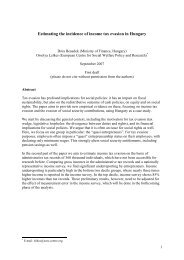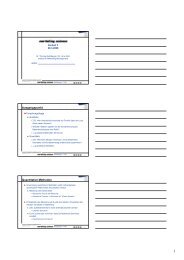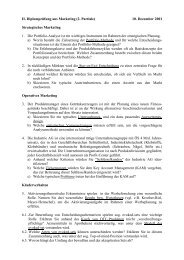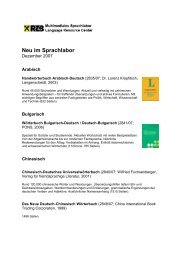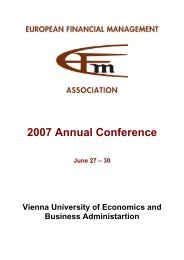Fund liquidation, self-selection and look-ahead bias in the hedge ...
Fund liquidation, self-selection and look-ahead bias in the hedge ...
Fund liquidation, self-selection and look-ahead bias in the hedge ...
You also want an ePaper? Increase the reach of your titles
YUMPU automatically turns print PDFs into web optimized ePapers that Google loves.
funds are more likely to disappear from <strong>the</strong> TASS database at<br />
perform<strong>in</strong>g<br />
own request. Second, we propose a method that will correct for <strong>self</strong>-<br />
<strong>the</strong>ir<br />
<strong>bias</strong> separately from <strong>the</strong> <strong>look</strong>-<strong>ahead</strong> <strong>bias</strong> due to fund <strong>liquidation</strong>.<br />
<strong>selection</strong><br />
while disentangl<strong>in</strong>g <strong>the</strong> effects of <strong>liquidation</strong> <strong>bias</strong> <strong>and</strong> <strong>self</strong>-<strong>selection</strong><br />
F<strong>in</strong>ally,<br />
we analyze <strong>the</strong> persistence <strong>in</strong> <strong>hedge</strong> fund performance over various<br />
<strong>bias</strong>,<br />
us<strong>in</strong>g <strong>the</strong> TASS database of <strong>hedge</strong> funds over <strong>the</strong> period 1994-<br />
horizons,<br />
The results <strong>in</strong>dicate that, <strong>in</strong> addition to <strong>liquidation</strong> <strong>bias</strong>, correct<strong>in</strong>g<br />
2000.<br />
Both<strong>bias</strong>eswork<strong>in</strong><strong>the</strong>samedirection<br />
for<strong>self</strong>-<strong>selection</strong><strong>bias</strong>isimportant.<br />
<strong>the</strong>ir comb<strong>in</strong>ed impact may result <strong>in</strong> overestimat<strong>in</strong>g expected returns<br />
<strong>and</strong><br />
a given decile by as much as 7.7% per year. As a result, <strong>the</strong> f<strong>in</strong>d<strong>in</strong>g<br />
with<strong>in</strong><br />
persistence <strong>in</strong> <strong>hedge</strong> fund performance is streng<strong>the</strong>ned once one corrects<br />
of<br />
both <strong>liquidation</strong> <strong>and</strong> <strong>self</strong>-<strong>selection</strong> <strong>bias</strong>es. At <strong>the</strong> annual horizon, <strong>the</strong><br />
for<br />
excess return on a w<strong>in</strong>ner m<strong>in</strong>us loser portfolio, based upon previousyearreturns,isapproximately10%<br />
expected<br />
when both <strong>bias</strong>es are corrected for,<br />
database, analyze fund attrition <strong>and</strong> relate it to <strong>liquidation</strong> <strong>and</strong> <strong>self</strong><strong>selection</strong>.<br />
TASS<br />
Moreover, we estimate probit specifications for both <strong>the</strong> liquida-<br />
<strong>and</strong> <strong>the</strong> <strong>self</strong>-<strong>selection</strong> decisions. Section 3 expla<strong>in</strong>s how one can correction<br />
for <strong>look</strong>-<strong>ahead</strong> <strong>bias</strong> due to <strong>liquidation</strong> <strong>and</strong> <strong>self</strong>-<strong>selection</strong> when analyz<strong>in</strong>g<br />
<strong>in</strong> <strong>hedge</strong> fund performance <strong>and</strong> how <strong>the</strong>se two <strong>bias</strong>es can be<br />
persistence<br />
Empirical results concern<strong>in</strong>g persistence at different horizons<br />
disentangled.<br />
presented <strong>in</strong> Section 4, while Section 5 conta<strong>in</strong>s some robustness checks.<br />
are<br />
Section 6 concludes.<br />
F<strong>in</strong>ally,<br />
data used <strong>in</strong> this paper are from TASS Management Limited <strong>and</strong> conta<strong>in</strong><br />
The<br />
<strong>in</strong>formation of 1797 <strong>hedge</strong> funds over <strong>the</strong> period 1994-2000, where we<br />
attention to funds report<strong>in</strong>g <strong>in</strong> US$. Although <strong>the</strong> TASS database<br />
restrict<br />
<strong>in</strong>formation of <strong>hedge</strong> funds s<strong>in</strong>ce 1979, we focus on <strong>the</strong> period 1994-<br />
conta<strong>in</strong>s<br />
for several reasons. First, <strong>in</strong>formation on “dead” funds is available only<br />
2000<br />
funds that disappeared s<strong>in</strong>ce 1994, <strong>and</strong> second, <strong>the</strong> number of funds be-<br />
for<br />
1994 is very small. As mentioned above, whe<strong>the</strong>r or not we observe<br />
fore<br />
for a given fund depends upon two ma<strong>in</strong> issues. First, <strong>the</strong> fund may<br />
returns<br />
without corrections.<br />
whileitisonly4.3%<br />
structure of this paper is as follows. In Section 2 we discuss <strong>the</strong><br />
The<br />
2 Liquidation <strong>and</strong> Self-<strong>selection</strong><br />
be liquidated. Second, if <strong>the</strong> fund is not liquidated, its management may<br />
4



